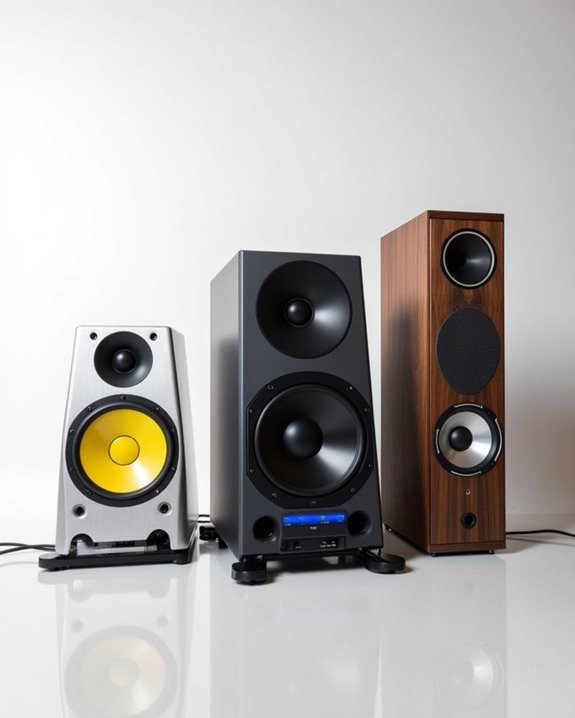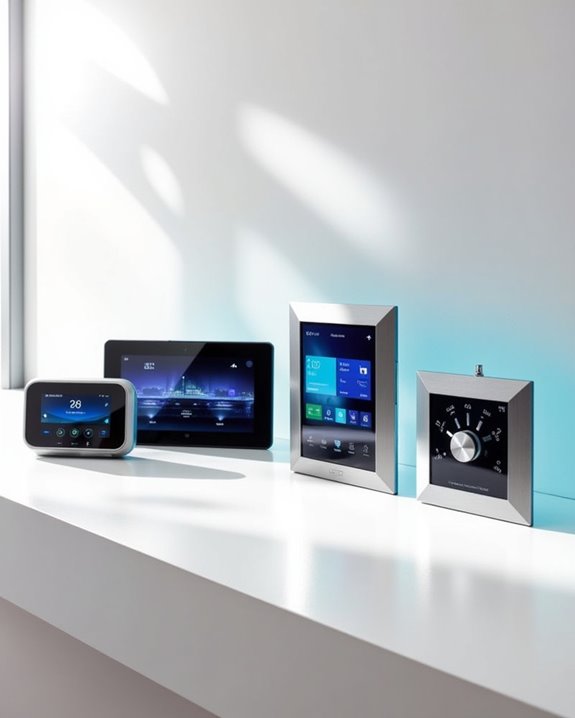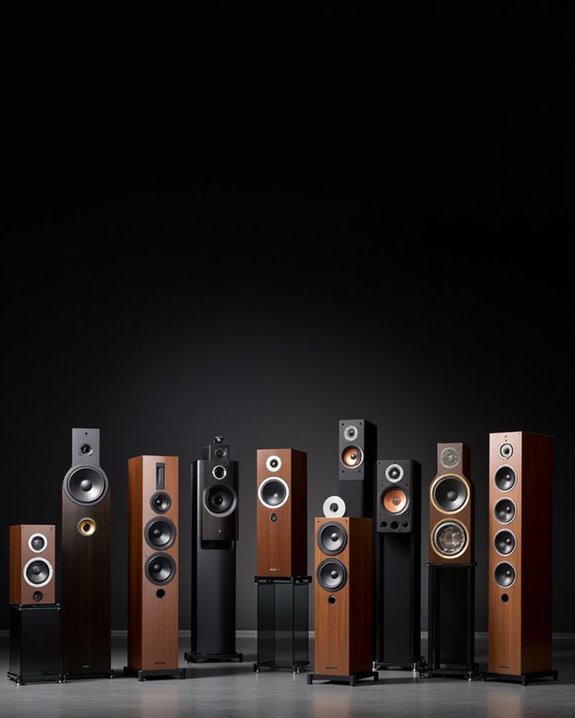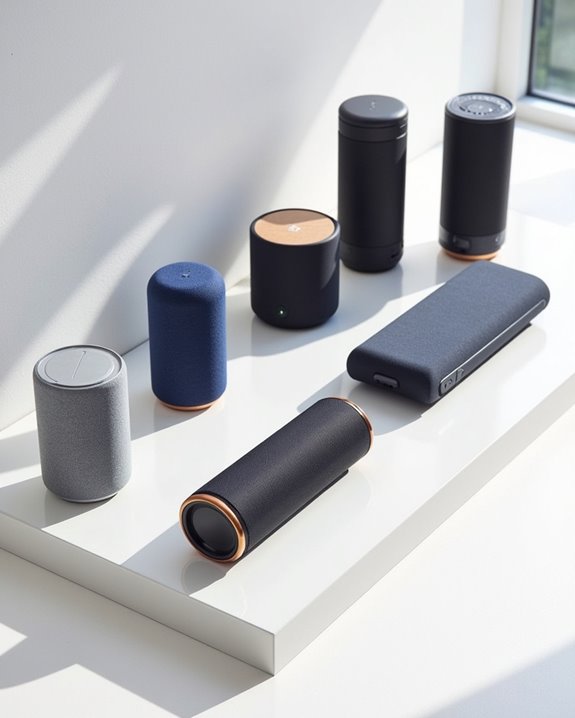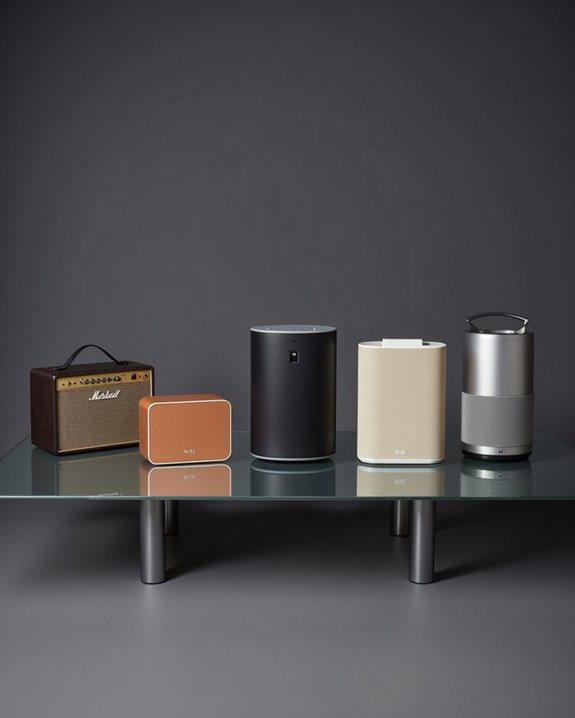The Klipsch R-51PM offers impressive sound with custom amplifiers, integrated phono pre-amp, and multiple connectivity options in a compact 10.6-pound package. The Edifier R1280DB delivers natural audio through 4-inch bass drivers and 13mm silk dome tweeters with convenient remote control and multiple inputs. The ALTO TX312 provides powerful 700W output with a 12-inch driver and titanium compression driver in a lightweight design for versatile positioning. Each speaker presents unique advantages depending on your specific listening environment and audio needs.
Key Takeaways
- Klipsch R-51PM offers impressive sound quality with custom amplifiers and versatile connectivity including Bluetooth, USB, and phono inputs.
- Edifier R1280DB provides excellent value with 42W RMS power, multiple input options, and user-friendly remote control features.
- ALTO TX312 delivers powerful 700W peak performance with a 12-inch driver and lightweight design perfect for venues and mobile applications.
- Class D amplification technology in powered speakers like the Klipsch R-51PM ensures efficiency and reduces heat during extended listening sessions.
- When choosing powered speakers, consider connectivity options, sound quality, size constraints, and specific features like Bluetooth range or bass response.
Klipsch R-51PM Powered Bluetooth Speaker,Black
- Powered monitor
- Bluetooth wireless technology
- Phono/line analog (with switch and ground screw terminal)
Audiophiles seeking powerful, versatile speakers without the complexity of external receivers will find the Klipsch R-51PM an exceptional choice. These 5.25-inch monitors deliver impressive performance with custom ultra-low noise amplifiers and dynamic volume technology that matches ear frequencies, providing robust bass at both low and high volumes.
Connectivity options abound with Bluetooth (10-meter range), phono/line analog inputs, USB digital, and optical inputs. The integrated phono pre-amp eliminates the need for external components. At 13.3H × 8.5W × 7D inches and weighing 10.6 pounds, these speakers fit comfortably on bookshelves while delivering clean, warm sound that customers consistently rate highly (4.6/5 stars from 2,458 reviews).
Best For: Audiophiles and tech enthusiasts seeking versatile, high-quality powered speakers that eliminate the need for external receivers while offering multiple connectivity options for turntables, TVs, computers, and mobile devices.
Pros:
- Impressive sound quality with dynamic volume technology that delivers powerful bass at both low and high volumes
- Versatile connectivity with Bluetooth, phono pre-amp, USB, optical, and analog inputs that accommodate virtually any audio source
- Compact yet powerful design with custom ultra-low noise amplifiers that provide clean, warm sound in a bookshelf-friendly size
Cons:
- No automatic input switching, requiring manual selection between sources
- Lacks crossover control for fine-tuning when paired with a subwoofer
- Requires some trial and error placement relative to walls for optimal bass response
Edifier R1280DB Powered Bluetooth Bookshelf Speakers (Black)
- BLUETOOTH WIRELESS - Popular classic bookshelf speakers now can be enjoyed without the hassle of wires. Simply connection to an iPhone, Android, Tablet, PC or Mac.
- STUDIO SOUND QUALITY - Naturally fine tuned sound reproduction from 4 inch bass and 13mm silk dome tweeter.
- OPTICAL AND COAXIAL INPUTS - Digital inputs to enable lossless connection to most TV and computers.
The Edifier R1280DB Powered Bluetooth Bookshelf Speakers represent an excellent entry point for home audio enthusiasts seeking versatility without breaking the bank. These 42W RMS speakers deliver impressive sound through 4-inch bass drivers and 13mm silk dome tweeters, producing naturally tuned audio with solid bass, midrange, and treble response.
You’ll appreciate the multiple connectivity options, including Bluetooth, optical, coaxial, and dual RCA inputs, allowing you to connect virtually any device from smartphones to televisions. The wooden enclosure provides acoustic isolation, while the front-facing bass reflex port enhances low-end performance. With side-mounted EQ controls and included remote, you can fine-tune your listening experience without leaving your seat.
Best For: Home audio enthusiasts seeking versatile, high-quality bookshelf speakers with multiple connectivity options at a mid-range price point.
Pros:
- Multiple connectivity options including Bluetooth, optical, coaxial, and RCA inputs for seamless integration with various devices
- Impressive sound quality with 4-inch bass drivers and 13mm silk dome tweeters delivering clear vocals and instruments with no background hiss
- User-friendly features including remote control, side-mounted EQ controls, and front-facing bass reflex port for enhanced low-end performance
Cons:
- At 4.9 kilograms (10.8 pounds), they may be heavier than some competing bookshelf speakers
- Not waterproof or water-resistant, limiting placement options in certain environments
- Requires a power outlet for operation, reducing portability compared to battery-powered alternatives
ALTO TX312 700W Powered DJ Speaker PA System
- Powerful PA System Sound – 2-Way 700-Watt Class D power amplifier; newly designed horn delivers stellar coverage at 90° H x 60° V. Designed and tuned in the USA
- Driving Bass, Pristine Highs - 12-inch (305 mm) LF driver, 2-inch (51 mm) voice coil; 1-inch (25.4 mm) titanium diaphragm HF compression driver
- Setup Simplified - Lightweight, PA cabinet design for easy transport, set up and installation; Suitable for pole-mounting or use as a wedge monitor
Professional DJs and event organizers seeking substantial power in a lightweight package will find the ALTO TX312 700W Powered DJ Speaker PA System compelling. This 10-pound speaker delivers impressive 700W peak power through its Class D amplifier, combining a 12-inch LF driver with a 1-inch titanium HF compression driver for exceptional audio clarity.
You’ll appreciate the versatile connectivity options, including XLR/TRS inputs and a Link Output for daisy-chaining. Its trapezoidal design enables both upright and monitor positioning, while the integrated limiter prevents distortion at high volumes. With a 90° H × 60° V coverage pattern and 20kHz frequency response, this system performs admirably across various venues from intimate clubs to community events.
Best For: Mobile DJs, small to medium event organizers, and gigging musicians who need a portable, powerful PA speaker with clear sound reproduction and versatile positioning options.
Pros:
- Extremely lightweight (10 pounds) design with handles makes transport and setup quick and effortless
- Versatile 700W system with both upright and monitor positioning capabilities suits multiple venue types
- Quality sound reproduction with 12-inch driver and titanium compression driver delivers clarity across frequencies
Cons:
- May experience clipping or potential failure when pushed to maximum volume for extended periods
- Not as durable or powerful as premium competitors like QSC or EV for large venue applications
- Single XLR/TRS input limits connectivity options compared to more feature-rich PA systems
Factors to Consider When Choosing Powered Speakers
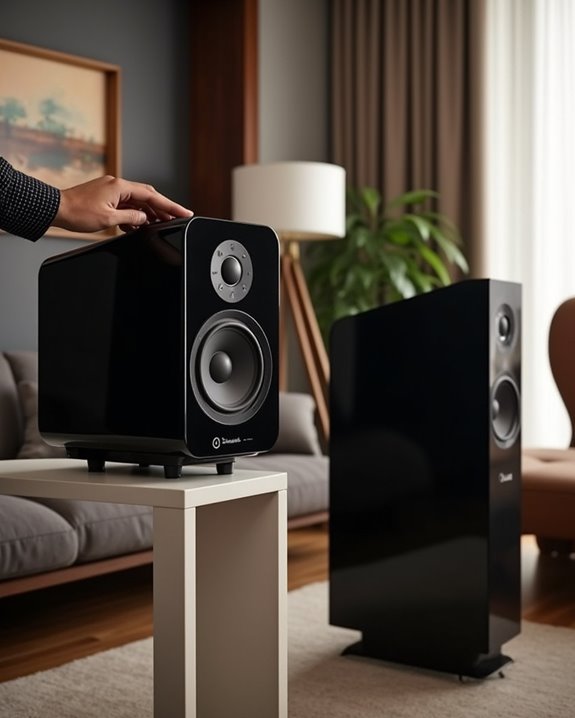
When selecting powered speakers for your setup, you’ll need to evaluate several critical factors that determine overall performance and compatibility. Your decision should account for power ratings and amplification technology, connectivity options, sound quality aspects like frequency response and driver configuration, size constraints relative to placement requirements, and environmental considerations specific to your intended usage scenario. These key considerations will help you navigate the wide range of available options, ensuring you choose a powered speaker system that delivers ideal audio performance for your specific needs.
Power and Amplification
Understanding power and amplification specifications serves as a critical foundation when selecting powered speakers for your audio setup. When evaluating options, focus on RMS wattage rather than peak power ratings, as RMS represents the continuous output capabilities your speakers can reliably maintain during regular use.
Pay attention to the amplification class implemented in your prospective speakers. Class D amplifiers offer superior efficiency, allowing for more compact designs and lower heat production during extended sessions. This efficiency translates directly to better performance in smaller spaces.
Built-in limiters and protection circuits are essential features to evaluate, as they’ll prevent distortion when you’re pushing your system to higher volumes. The integration of quality amplifiers within powered speakers eliminates signal loss that typically occurs with separate components, resulting in cleaner audio reproduction across all volume levels.
Connectivity Options
Modern powered speakers offer a diverse array of connectivity options that directly impact your system’s versatility and performance. When evaluating potential models, you’ll want to assess both analog and digital inputs, with the latter providing superior signal integrity and reduced interference. Look for speakers featuring multiple connection types—XLR, RCA, optical, coaxial, and USB ports—to guarantee compatibility with mixers, computers, and other audio sources.
Wireless capabilities, particularly Bluetooth with its typical 10-meter range, eliminate cable clutter when connecting mobile devices. You’ll also benefit from examining output options, such as dedicated subwoofer ports or link connections, which allow for system expansion. Pay attention to connectivity protocol versions (Bluetooth 5.0+, USB-C) to future-proof your investment and maintain compatibility with newer equipment as technology evolves.
Sound Quality Aspects
How well your powered speakers perform ultimately depends on several critical sound quality factors that directly impact your listening experience. When evaluating options, pay close attention to the frequency response, which should ideally cover the full 20Hz-20kHz range for complete audio reproduction.
Consider the dynamic range capabilities, as speakers with wider ranges will deliver more detailed sound from quiet passages to crescendos. Check the total harmonic distortion (THD) percentage—lower values (under 1%) provide cleaner, more accurate audio. The signal-to-noise ratio should exceed 85dB for minimal background interference.
Driver specifications matter importantly; larger woofers (5-8 inches) typically provide deeper bass, while high-quality tweeter materials like silk or beryllium deliver crisp highs without harshness. These technical aspects, when optimized, translate to immersive, fatigue-free listening.
Size and Placement
Size and placement considerations go hand-in-hand with sound quality when selecting powered speakers that will perform effectively in your specific environment. The physical dimensions—height, width, and depth—directly determine whether your speakers will fit comfortably on shelves, desktops, or stands without compromising your available space.
Weight is an essential factor if you’ll need to transport your speakers regularly, with lighter models (under 15 pounds) offering superior portability for event setups or temporary installations. Driver sizes affect both footprint and acoustic properties; larger 8″ woofers deliver deeper bass but require more room for ideal sound dispersion. Position speakers at least 6-12 inches from walls to prevent bass buildup, especially in smaller rooms. Many modern powered monitors feature trapezoidal enclosures that enable versatile placement options, including horizontal orientation for space-constrained environments or angled positioning for near-field monitoring.
Intended Usage Environment
The environment where you’ll deploy your powered speakers dramatically impacts which models will deliver best performance for your specific needs. Indoor versus outdoor usage presents your first critical decision point, with outdoor installations requiring weather-resistant features to protect against moisture damage and guarantee longevity.
Space dimensions and acoustic properties dictate power requirements, measured in watts, with larger venues necessitating higher outputs for consistent sound coverage. Consider ambient noise levels carefully—environments with significant background noise may require speakers capable of producing 120 dB or higher for clear audio projection. For mobile setups or temporary events, prioritize speakers under 15 pounds with robust construction for easy transport. Finally, evaluate power availability at your location, as standard powered speakers require reliable AC sources, while remote settings might benefit from models offering battery backup options.
Frequently Asked Questions
Can Powered Speakers Be Used With a Turntable?
Yes, you can use powered speakers with a turntable, but you’ll need a phono preamp. Most modern powered speakers accept line-level signals (via RCA, 3.5mm, or XLR inputs), while turntables output phono-level signals requiring amplification. Some turntables have built-in preamps, eliminating this requirement. When connecting, verify proper grounding to prevent hum. Many audiophiles prefer powered speakers for vinyl setups due to their integrated amplification, simplified wiring, and space efficiency compared to traditional component systems.
How Do I Connect Multiple Powered Speakers Together?
Ah, the quest to create your own personal concert hall—such ambition! You can connect multiple powered speakers using several methods. The simplest approach is to use the “daisy chain” feature, connecting the output of one speaker to the input of the next using RCA or XLR cables. Alternatively, use a dedicated audio interface or mixer with multiple outputs. Some modern powered speakers offer wireless connectivity via Bluetooth or Wi-Fi, allowing you to create multi-room systems without physical connections.
What’s the Difference Between Active and Passive Speakers?
Active speakers have built-in amplifiers, allowing you to connect audio sources directly without additional equipment. You’ll find everything needed for sound reproduction contained within the speaker cabinet. Passive speakers, conversely, require external amplification through a separate receiver or amplifier to function. The primary distinction lies in power sourcing: active speakers plug directly into wall outlets, while passive speakers receive power through speaker wire from your external amplifier. Active models offer convenience, while passive systems provide flexibility for component upgrades.
Are Powered Speakers Good for Outdoor Use?
Powered speakers can be excellent for outdoor use, provided they’re designed for such environments. Look for weather-resistant models with IPX4 or higher ratings for moisture protection. You’ll need to evaluate power source accessibility, as these require outlets or battery options. Many outdoor-rated powered speakers offer enhanced bass response and volume capability to overcome ambient noise. For permanent installations, make sure they’re mounted in sheltered locations to extend longevity and maintain sound quality despite environmental exposure.
Do Powered Speakers Need an Amplifier?
No, powered speakers don’t need an external amplifier. They have built-in amplification circuits that convert line-level audio signals directly into speaker-level output. This integrated design eliminates the need for separate components, saving space and reducing setup complexity. You’ll only need to connect your audio source (smartphone, computer, turntable with preamp) directly to the powered speakers. For outdoor use, look for models with higher power ratings (50W+ per channel) and weather-resistant construction to guarantee adequate sound projection.

